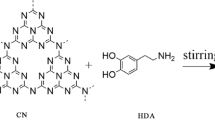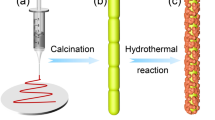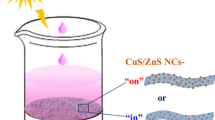Abstract
Novel p–n heterojunction of Cu2O/Bi2O2CO3 photocatalysts with various proportion of Cu2O are synthesized by the precipitation method at room temperature, which are then combined with electrospinning method and electron beam irradiation to construct a photocatalyst-polymer structure. The results indicated that the Cu2O/Bi2O2CO3 photocatalyst obtained, in contrast to the pure Bi2O2CO3, enabled improved visible-light absorption, which can separate and migrate the charge carriers efficiently via solid p–n heterojunction interfacial effect. Accordingly, the Cu2O/Bi2O2CO3/PEO nanofibers allowed for the higher visible-light-responsive photocatalytic activity for the degradation of chloramphenicol (CAP), which the highest degradation efficiency is 98.2% for CAP in 30 min and obviously higher than that of Bi2O2CO3 membrane. In addition, combining cytotoxicity experiments with LC-IT-QTOF, it is found that intermediates such as DH-CAP and NO-CAP produced during the degradation of CAP are main possible reasons for the increase in the solution cytotoxicity. Besides, the obtained materials show significant inhibition against Escherichia coli and Staphylococcus aureus with the maximum inhibition rates of 81.5% and 75.6%, respectively.












Similar content being viewed by others
References
Lyu J, Shao J, Wang Y, Qiu Y, Li J, Li T, Peng Y, Liu F (2019) Construction of a porous core-shell homojunction for the photocatalytic degradation of antibiotics. Chem Eng J 358:614–620
Li L, Cai J, Yan Y, Zhao F, Zhou J (2019) Flower-like direct Z-scheme WS2/Bi2O2CO3 photocatalyst with enhanced photocatalytic activity. J Alloys Compd 810:151872
Jiang L, Wang Y, Feng C (2012) Application of photocatalytic technology in environmental safety. Procedia Eng 45:993–997
Asahi R, Morikawa T, Ohwaki T, Aoki K, Taga Y (2001) Visible-light photocatalysis in nitrogen-doped titanium oxides. Science 293(5528):269–271
Nakata K, Fujishima A (2012) TiO2 photocatalysis: design and applications. J Photochem Photobiol C 13(3):169–189
Schneider J, Matsuoka M, Takeuchi M, Zhang J, Horiuchi Y, Anpo M, Bahnemann DW (2014) Understanding TiO2 photocatalysis: mechanisms and materials. Chem Rev 114(19):9919–9986
Zargazi M, Entezari MH (2019) Anodic electrophoretic deposition of Bi2WO6 thin film: high photocatalytic activity for degradation of a binary mixture. Appl Catal B 242:507–517
Liu Z, Sun DD, Guo P, Leckie JO (2007) An efficient bicomponent TiO2/SnO2 nanofiber photocatalyst fabricated by electrospinning with a side-by-side dual spinneret method. Nano Lett 7(4):1081–1085
Bai P, Tong X, Wan J, Gao Y, Xue S (2019) Flower-like Bi2O2CO3-mediated selective oxidative coupling processes of amines under visible light irradiation. J Catal 374:257–265
Cheng H, Huang B, Yang K, Wang Z, Qin X, Zhang X, Dai Y (2010) Facile template-free synthesis of Bi2O2CO3 hierarchical microflowers and their associated photocatalytic activity. Chem Phys Chem 11(10):2167–2173
Liu Y, Wang Z, Huang B, Yang K, Zhang X, Qin X, Dai Y (2010) Preparation, electronic structure, and photocatalytic properties of Bi2O2CO3 nanosheet. Appl Surf Sci 257(1):172–175
Hu J, Chen D, Li N, Xu Q, Li H, He J, Lu J (2018) Recyclable carbon nanofibers@hierarchical I-doped Bi2O2CO3–MoS2 membranes for highly efficient water remediation under visible-light irradiation. ACS Sustain Chem Eng 6(2):2676–2683
Jin L, Zhu G, Hojamberdiev M, Luo X, Tan C, Peng J, Wei X, Li J, Liu P (2014) A plasmonic Ag–AgBr/Bi2O2CO3 composite photocatalyst with enhanced visible-light photocatalytic activity. Ind Eng Chem Res 53(35):13718–13727
Tian N, Huang H, Guo Y, He Y, Zhang Y (2014) Ag-C3N4/Bi2O2CO3 composite with high visible-light-driven photocatalytic activity for rhodamine B degradation. Appl Surf Sci 322:249–254
Chen C, Cai W, Long M, Zhou B, Wu Y, Wu D, Feng Y (2010) Synthesis of visible-light responsive graphene oxide/TiO2 composites with p/n heterojunction. ACS Nano 4(11):6425–6432
Wang H, Zhang L, Chen Z, Hu J, Li S, Wang Z, Liu J, Wang X (2014) Semiconductor heterojunction photocatalysts: design, construction, and photocatalytic performances. Chem Soc Rev 43(15):5234–5244
Low J, Yu J, Jaroniec M, Wageh S, Al-Ghamdi AA (2017) Heterojunction photocatalysts. Adv Mater 29(20):1601694
Fan H, Zhou H, Li W, Gu S, Zhou G (2020) Facile fabrication of 2D/2D step-scheme In2S3/Bi2O2CO3 heterojunction towards enhanced photocatalytic activity. Appl Surf Sci 504:144351
Qiu F, Li W, Wang F, Li H, Liu X, Ren C (2017) Preparation of novel p–n heterojunction Bi2O2CO3/BiOBr photocatalysts with enhanced visible light photocatalytic activity. Colloids Surf A 517:25–32
Liang N, Wang M, Jin L, Huang S, Chen W, Xu M, He Q, Zai J, Fang N, Qian X (2014) Highly efficient Ag2O/Bi2O2CO3p–n heterojunction photocatalysts with improved visible-light responsive activity. ACS Appl Mater Interfaces 6(14):11698–11705
Liu L, Yang W, Li Q, Gao S, Shang JK (2014) Synthesis of Cu2O nanospheres decorated with TiO2 nanoislands, their enhanced photoactivity and stability under visible light illumination, and their post-illumination catalytic memory. ACS Appl Mater Interfaces 6(8):5629–5639
Karthik AD, Geetha K (2013) Synthesis of copper precursor, copper and its oxide nanoparticles by green chemical reduction method and its antimicrobial activity. J Appl Pharm Sci 3(5):16
Ren J, Wang W, Sun S, Zhang L, Wang L, Chang J (2011) Crystallography facet-dependent antibacterial activity: the case of Cu2O. Ind Eng Chem Res 50(17):10366–10369
Michalet X, Pinaud FF, Bentolila LA, Tsay JM, Doose S, Li JJ, Sundaresan G, Wu A, Gambhir S, Weiss S (2005) Quantum dots for live cells, in vivo imaging, and diagnostics. Science 307(5709):538–544
McGuire JA, Sykora M, Joo J, Pietryga JM, Klimov VI (2010) Apparent versus true carrier multiplication yields in semiconductor nanocrystals. Nano Lett 10(6):2049–2057
Cui W, An W, Liu L, Hu J, Liang Y (2014) Novel Cu2O quantum dots coupled flower-like BiOBr for enhanced photocatalytic degradation of organic contaminant. J Hazard Mater 280:417–427
Doh SJ, Kim C, Lee SG, Lee SJ, Kim H (2008) Development of photocatalytic TiO2 nanofibers by electrospinning and its application to degradation of dye pollutants. J Hazard Mater 154(1–3):118–127
Pei CC, Leung WW-F (2013) Photocatalytic degradation of rhodamine B by TiO2/ZnO nanofibers under visible-light irradiation. Sep Purif Technol 114:108–116
Wang X, Choi J, Mitchell DRG, Truong YB, Kyratzis IL, Caruso RA (2013) Enhanced photocatalytic activity: macroporous electrospun mats of mesoporous Au/TiO2 Nanofibers. Chem Cat Chem 5(9):2646–2654
Guan X, Zheng G, Dai K, Liu C, Yan X, Shen C, Guo Z (2016) Carbon nanotubes-adsorbed electrospun PA66 nanofiber bundles with improved conductivity and robust flexibility. ACS Appl Mater Interfaces 8(22):14150–14159
Xu Q, Song Z, Ji S, Xu G, Shi W, Shen L (2019) The photocatalytic degradation of chloramphenicol with electrospun Bi2O2CO3-poly(ethylene oxide) nanofibers: the synthesis of crosslinked polymer, degradation kinetics, mechanism and cytotoxicity. RSC Adv 9(51):29917–29926
Intarasuwan K, Amornpitoksuk P, Suwanboon S, Graidist P (2017) Photocatalytic dye degradation by ZnO nanoparticles prepared from X2C2O4 (X=H, Na and NH4) and the cytotoxicity of the treated dye solutions. Sep Purif Technol 177:304–312
Zai J, Cao F, Liang N, Yu K, Tian Y, Sun H, Qian X (2017) Rose-like I-doped Bi2O2CO3 microspheres with enhanced visible light response: DFT calculation, synthesis and photocatalytic performance. J Hazard Mater 321:464–472
Guo G, Yan H (2020) Zn-doped Bi2O2CO3: Synthesis, characterization and photocatalytic properties. Chem Phys 538:110920
Yao M-h, Tang Y-g, Zhang L, Yang H-h, Yan J-h (2010) Photocatalytic activity of CuO towards HER in catalyst from oxalic acid solution under simulated sunlight irradiation. Trans Nonferrous Metals Soc China 20(10):1944–1949
He K, Tadesse Tsega T, Liu X, Zai J, Li XH, Liu X, Li W, Ali N, Qian X (2019) Utilizing the space-charge region of the FeNi-LDH/CoP p–n junction to promote performance in oxygen evolution electrocatalysis. Angew Chem Int Ed Engl 58(34):11903–11909
Zheng X, Yang L, Li Y, Yang L, Luo S (2019) Direct Z-scheme MoSe2 decorating TiO2 nanotube arrays photocatalyst for water decontamination. Electrochim Acta 298:663–669
Wang M, Sun L, Lin Z, Cai J, Xie K, Lin C (2013) p–n heterojunction photoelectrodes composed of Cu2O-loaded TiO2 nanotube arrays with enhanced photoelectrochemical and photoelectrocatalytic activities. Energy Environ Sci 6(4):1211–1220
Lee G, Ibrahim S, Kittappa S, Park H, Park CM (2018) Sonocatalytic activity of a heterostructured β-Bi2O3/Bi2O2CO3 nanoplate in degradation of bisphenol A. Ultrason Sonochem 44:64–72
He K, Zai J, Liu X, Zhu Y, Iqbal A, Tsega TT, Zhang Y, Ali N, Qian X (2020) One-step construction of multi-doped nanoporous carbon-based nanoarchitecture as an advanced bifunctional oxygen electrode for Zn-Air batteries. Appl Catal B Environ 265:118594
Ahmad T, Iqbal J, Bustam MA, Zulfiqar M, Muhammad N, Al Hajeri BM, Irfan M, Asghar HMA, Ullah S (2020) Phytosynthesis of cerium oxide nanoparticles and investigation of their photocatalytic potential for degradation of phenol under visible light. J Mol Struct 1217:128292
Liang N, Zai J, Xu M, Zhu Q, Wei X, Qian X (2014) Novel Bi2S3/Bi2O2CO3 heterojunction photocatalysts with enhanced visible light responsive activity and wastewater treatment. J Mater Chem A 2(12):4208–4216
Zhou M, Han D, Liu X, Ma C, Wang H, Tang Y, Huo P, Shi W, Yan Y, Yang J (2015) Enhanced visible light photocatalytic activity of alkaline earth metal ions-doped CdSe/rGO photocatalysts synthesized by hydrothermal method. Appl Catal B 172–173:174–184
Zuo S, Chen J, Liu W, Yao C, Mao H, Li Y, Fu Y, Liu X (2017) Photocatalytic activity of flower-like carbon/Ag3PO4 composite microspheres for pollutant degradation. Mater Lett 190:134–137
Wen X-J, Niu C-G, Zhang L, Liang C, Zeng G-M (2018) A novel Ag2O/CeO2 heterojunction photocatalysts for photocatalytic degradation of enrofloxacin: possible degradation pathways, mineralization activity and an in depth mechanism insight. Appl Catal B 221:701–714
Hu C, Chen TS, Huang HX (2017) Heterojunction of n-type Sr2TiO4 with p-type Bi5O7I with enhanced photocatalytic activity under irradiation of simulated sunlight. Appl Surf Sci 426:536–544
Guan DL, Niu CG, Wen XJ, Guo H, Deng CH, Zeng GM (2018) Enhanced Escherichia coli inactivation and oxytetracycline hydrochloride degradation by a Z-scheme silver iodide decorated bismuth vanadate nanocomposite under visible light irradiation. J Colloid Interface Sci 512:272–281
Zhu B, Xia P, Li Y, Ho W, Yu J (2017) Fabrication and photocatalytic activity enhanced mechanism of direct Z-scheme g-C3N4/Ag2WO4 photocatalyst. Appl Surf Sci 391:175–183
Wu S, Zheng H, Lian Y, Wu Y (2013) Preparation, characterization and enhanced visible-light photocatalytic activities of BiPO4/BiVO4 composites. Mater Res Bull 48(8):2901–2907
Wang Y, Bai X, Pan C, He J, Zhu Y (2012) Enhancement of photocatalytic activity of Bi2WO6 hybridized with graphite-like C3N4. J Mater Chem 22(23):11568–11573
He K, Tsega TT, Liu X, Zai J, Li XH, Liu X, Li W, Ali N, Qian X (2019) Utilizing the space-charge region of the FeNi-LDH/CoP p–n junction to promote performance in oxygen evolution electrocatalysis. Angew Chem Int Ed Engl 58(34):11903–11909
Ali S, Humayun M, Pi W, Yuan Y, Wang M, Khan A, Yue P, Shu L, Zheng Z, Fu Q, Luo W (2020) Fabrication of BiFeO3-g-C3N4-WO3 Z-scheme heterojunction as highly efficient visible-light photocatalyst for water reduction and 2,4-dichlorophenol degradation: Insight mechanism. J Hazard Mater 397:122708
Li X, Yu J, Low J, Fang Y, Xiao J, Chen X (2015) Engineering heterogeneous semiconductors for solar water splitting. J Mater Chem A 3(6):2485–2534
Uthirakumar P, Devendiran M, Kuznetsov AY, Kim GC, Lee IH (2020) Efficient, recyclable, and affordable daylight induced Cu/Cu2O/CuI photocatalyst via an inexpensive iodine sublimation process. Appl Surf Sci 537:147007
Çinar B, Keri̇moğlu I, Tönbül B, Demi̇rbüken A, Dursun S, Kaya IC, Kalem V, Akyildiz H (2020) Hydrothermal/electrospinning synthesis of CuO plate-like particles/TiO2 fibers heterostructures for high-efficiency photocatalytic degradation of organic dyes and phenolic pollutants. Mater Sci Semicond Process 109:104919
Dursun S, Kaya IC, Kalem V, Akyildiz H (2018) UV/Visible light active CuCrO2 nanoparticle-SnO2 nanofiber p–n heterostructured photocatalysts for photocatalytic applications. Dalton Trans 47(41):14662–14678
Dursun S, Kaya İC, Kocabaş M, Akyildiz H, Kalem V (2020) Visible light active heterostructured photocatalyst system based on CuO plate-like particles and SnO2 nanofibers. Int J Appl Ceram Technol 17(3):1479–1489
Liu L, Ding L, Liu Y, An W, Lin S, Liang Y, Cui W (2016) Enhanced visible light photocatalytic activity by Cu2O-coupled flower-like Bi2WO6 structures. Appl Surf Sci 364:505–515
Ma R, Zhang S, Wen T, Gu P, Li L, Zhao G, Niu F, Huang Q, Tang Z, Wang X (2019) A critical review on visible-light-response CeO2-based photocatalysts with enhanced photooxidation of organic pollutants. Catal Today 335:20–30
Frame FA, Osterloh FE (2010) CdSe-MoS2: A Quantum Size-Confined Photocatalyst for Hydrogen Evolution from Water under Visible Light. J Phys Chem C 114(23):10628–10633
Cai T, Zeng W, Liu Y, Wang L, Dong W, Chen H, Xia X (2020) A promising inorganic-organic Z-scheme photocatalyst Ag3PO4/PDI supermolecule with enhanced photoactivity and photostability for environmental remediation. Appl Catal B Environ 263:118327
Li X, Wu N, Chen Y, Tan J, Wang J, Geng L, Qin Y, Zhang Q (2020) Degradation of different molecular weight fucoidans and their inhibition of TGF-beta1 induced epithelial-mesenchymal transition in mouse renal tubular epithelial cells. Int J Biol Macromol 151:545–553
Gao B, Dong S, Liu J, Liu L, Feng Q, Tan N, Liu T, Bo L, Wang L (2016) Identification of intermediates and transformation pathways derived from photocatalytic degradation of five antibiotics on ZnIn2S4. Chem Eng J 304:826–840
Zhanga Y (2018) Kinetics and by-products formation of chloramphenicol (CAP) using chlorination and photocatalytic oxidation. Chem Eng J 331:85–91
Ricardo IA (2018) Degradation and initial mechanism pathway of chloramphenicol by photoFenton process at circumneutral pH. Chem Eng J 339:531–538
Robbana-Barnat S, Decloitre F, Frayssinet C, Seigneurin J, Toucas L, Lafarge-Frayssinet C (1997) Use of human lymphoblastoid cells to detect the toxic effect of chloramphenicol and metabolites possibly involved in aplastic anemia in man. Drug Chem Toxicol 20(3):239–253
Yunis AA (1988) Chloramphenicol: relation of structure to activity and toxicity. Annu Rev Pharmacol Toxicol 28(1):83–100
Abou-Khalil WH, Yunis AA, Abou-Khalil S (1988) Stability of chloramphenicol metabolites in human blood and liver as determined by high-performance liquid chromatography. Pharmacology 36(4):272–278
Lafarge-Frayssinet C, Robbana-Barnat S, Frayssinet C, Toucas L, Decloitre F (1994) Cytotoxicity and DNA damaging potency of chloramphenicol and six metabolites: a new evaluation in human lymphocytes and Raji cells. Mutat Res/Genet Toxicol 320(3):207–215
Yang Z, Pan D, Xi C, Li J, Shi J, Xu F, Ma Z (2013) Surfactant-assisted nanocrystal filling of TiO2 nanotube arrays for dye-sensitized solar cells with improved performance. J Power Sources 236:10–16
Hong R, Kang TY, Michels CA, Gadura N (2012) Membrane lipid peroxidation in copper alloy-mediated contact killing of Escherichia coli. Appl Environ Microbiol 78(6):1776–1784
Macomber L, Rensing C, Imlay JA (2007) Intracellular copper does not catalyze the formation of oxidative DNA damage in Escherichia coli. J Bacteriol 189(5):1616–1626
Mallick S, Sharma S, Banerjee M, Ghosh SS, Chattopadhyay A, Paul A (2012) Iodine-stabilized Cu nanoparticle chitosan composite for antibacterial applications. ACS Appl Mater Interfaces 4(3):1313–1323
Stadtman ER, Levine RL (2003) Free radical-mediated oxidation of free amino acids and amino acid residues in proteins. Amino Acids 25(3):207–218
Warnes SL, Caves V, Keevil CW (2012) Mechanism of copper surface toxicity in Escherichia coli O157: H7 and salmonella involves immediate membrane depolarization followed by slower rate of DNA destruction which differs from that observed for Gram-positive bacteria. Environ Microbiol 14(7):1730–1743
Acknowledgements
This work was supported by the National Natural Science Foundation of China (Nos. 11775138, 12075146, 11675098 and 41473089), Innovation Program of Shanghai Municipal Education Commission (No. 13YZ017) and Program for Changjiang Scholars and Innovative Research Team in University (No. IRT13078).
Author information
Authors and Affiliations
Corresponding authors
Ethics declarations
Conflict of interest
The authors have no competing financial interests to declare.
Additional information
Handling Editor: Gregory Rutledge.
Publisher's Note
Springer Nature remains neutral with regard to jurisdictional claims in published maps and institutional affiliations.
Electronic supplementary material
Below is the link to the electronic supplementary material.
Rights and permissions
About this article
Cite this article
Wang, Q., Ji, S., Xu, Q. et al. Preparation of PEO-based Cu2O/Bi2O2CO3 electrospun fibrous membrane toward enhanced photocatalytic degradation of chloramphenicol. J Mater Sci 56, 4599–4614 (2021). https://doi.org/10.1007/s10853-020-05564-9
Received:
Accepted:
Published:
Issue Date:
DOI: https://doi.org/10.1007/s10853-020-05564-9




